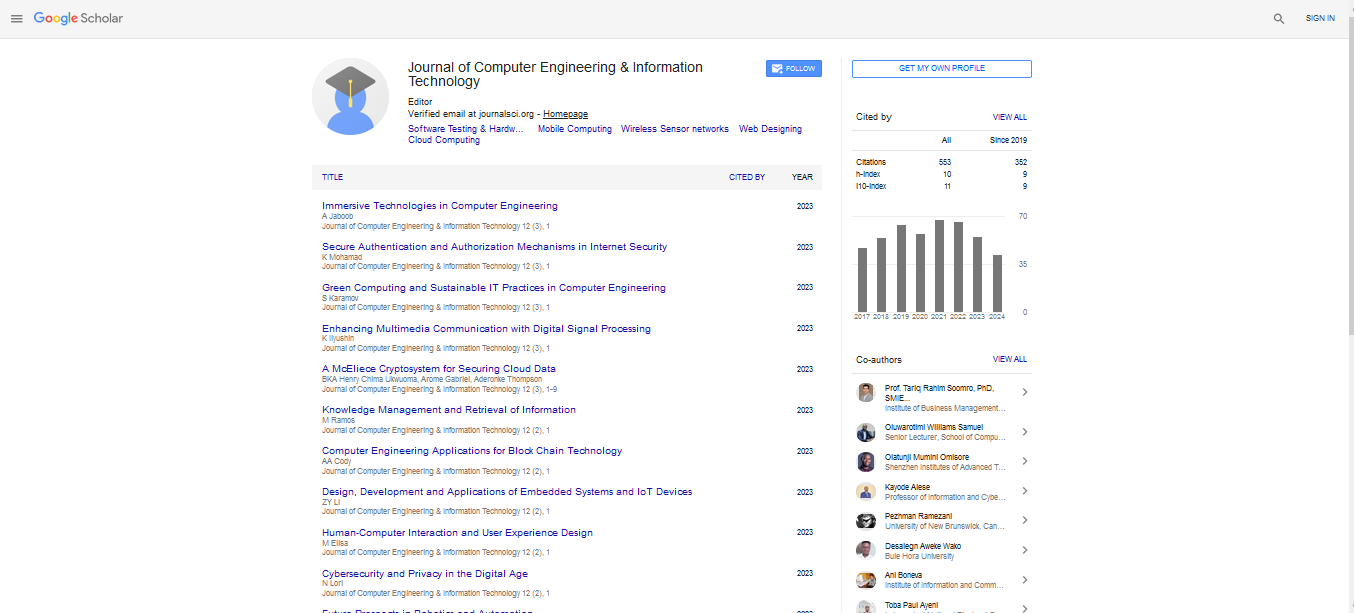Editorial, Jceit Vol: 14 Issue: 1
Cyber Threat Intelligence: Staying Ahead in the Cybersecurity Arms Race
Tejas Modi*
Department of CSE, Adani University, Ahmedabad, Gujarat, India
- *Corresponding Author:
- Tejas Modi
Department of CSE, Adani University, Ahmedabad, Gujarat, India
E-mail: modi_tejas@gmail.com
Received: 01-Jan-2025, Manuscript No. jceit-25-169303; Editor assigned: 4-Jan-2025, Pre-QC No. jceit-25-169303 (PQ); Reviewed: 20-Jan-2025, QC No jceit-25-169303; Revised: 27-Jan-2025, Manuscript No. jceit-25-169303 (R); Published: 31-Jan-2025, DOI: 10.4172/2324-9307.1000328
Citation: Tejas M (2025) Cyber Threat Intelligence: Staying Ahead in the Cybersecurity Arms Race. J Comput Eng Inf Technol 14: 328
Introduction
In an era where cyberattacks are more frequent, sophisticated, and damaging than ever before, organizations can no longer afford to be reactive. Traditional defenses like firewalls and antivirus software are no match for today’s dynamic and well-funded threat actors. To stay ahead, businesses and governments are turning to Cyber Threat Intelligence [1] (CTI)—a proactive approach to understanding and anticipating digital threats before they strike.
Cyber Threat Intelligence is more than just gathering data; it involves analyzing threat information from multiple sources, understanding attacker behavior, and applying that knowledge to strengthen defenses. It turns raw data into actionable insights, allowing organizations to detect attacks earlier, respond faster, and make better-informed security decisions.
As cyber threats grow more complex and damaging, CTI is becoming the cornerstone of effective, modern cybersecurity.
What Is Cyber Threat Intelligence?
Cyber Threat Intelligence (CTI) refers to the collection, analysis, and dissemination of information about potential or existing cyber threats [2]. This intelligence helps security teams understand the motives, targets, tactics, techniques, and procedures (TTPs) of threat actors.
CTI typically falls into three categories:
Strategic Intelligence – High-level trends and risks to inform executive decision-making.
Tactical Intelligence – Specific information on attacker behavior and malware techniques.
Operational Intelligence – Insights into specific attacks or campaigns, often used for incident response.
What sets CTI apart from general cybersecurity practices is its predictive power [3]. By studying adversaries and their methods, CTI equips organizations to not just detect attacks but anticipate and disrupt them.
Why CTI Matters Now More Than Ever
Cyberattacks are no longer isolated or opportunistic—they are increasingly organized, state-sponsored, and financially motivated. Recent high-profile breaches, like those of SolarWinds and MOVEit, illustrate how adversaries can infiltrate trusted software supply chains and remain undetected for months.
CTI provides early warning indicators of such threats by monitoring dark web forums, hacker communities, malware signatures, and suspicious network activity. It enables organizations to:
Identify emerging threats and vulnerabilities before they are exploited.
Prioritize security resources based on the most relevant risks.
Improve incident response with real-time threat context.
Align defenses with attacker tactics using frameworks like MITRE ATT&CK.
Furthermore, CTI fosters collaboration across sectors, enabling threat-sharing initiatives that benefit entire industries and governments.
Challenges in Implementing Effective CTI
Despite its importance, implementing a robust CTI program presents several challenges:
Data Overload: The sheer volume of threat data can overwhelm security teams if not properly filtered and contextualized.
False Positives: Without skilled analysis, raw threat feeds can lead to unnecessary alerts and wasted effort.
Integration Gaps: CTI must be embedded into security operations and tools (SIEMs, SOAR platforms) to be actionable.
Talent Shortage: There’s a global shortage of professionals skilled in threat intelligence and analysis.
Trust and Sharing: Many organizations are hesitant to share threat data due to competitive concerns or legal implications [4].
Overcoming these barriers requires not just technology, but strategy—organizations need to invest in skilled analysts, foster a culture of information sharing, and ensure CTI is operationalized across all layers of defense.
CTI in Action: Real-World Impact
When deployed effectively, Cyber Threat Intelligence can significantly reduce risk. For instance:
Financial institutions use CTI to monitor for leaked credentials and fraud indicators on the dark web.
Healthcare providers leverage CTI to guard against ransomware groups targeting medical records [5].
Government agencies rely on CTI to detect nation-state espionage campaigns and influence operations.
By integrating CTI into their security programs, these organizations not only strengthen their defenses but also gain situational awareness that turns them from passive targets into proactive defenders.
Conclusion
Cyber Threat Intelligence is not just a buzzword—it is a critical component of a resilient cybersecurity strategy in the digital age. In a landscape where the question is not if but when an attack will occur, CTI enables organizations to prepare, prevent, and respond with confidence.
By understanding adversaries and their tactics, CTI empowers organizations to move from reactive defense to proactive threat hunting and risk mitigation. As cyber threats continue to escalate, investing in intelligence-driven security is not an option—it’s a necessity. Those who harness CTI today are the ones who will outpace the threats of tomorrow.
References
- National Institute of Standards and Technology (NIST). (2022). Cyber Threat Intelligence Integration.
- MITRE Corporation. (2024). MITRE ATT&CK® Framework.
- Mandiant. (2023). Cyber Threat Intelligence Best Practices.
- IBM X-Force. (2024). Threat Intelligence Index 2024.
- Cybersecurity & Infrastructure Security Agency (CISA) (2023) Sharing Cyber Threat Intelligence.
Indexed at, Google Scholar, Crossref
Indexed at, Google Scholar, Crossref
Indexed at, Google Scholar, Crossref
Indexed at, Google Scholar, Crossref
 Spanish
Spanish  Chinese
Chinese  Russian
Russian  German
German  French
French  Japanese
Japanese  Portuguese
Portuguese  Hindi
Hindi 